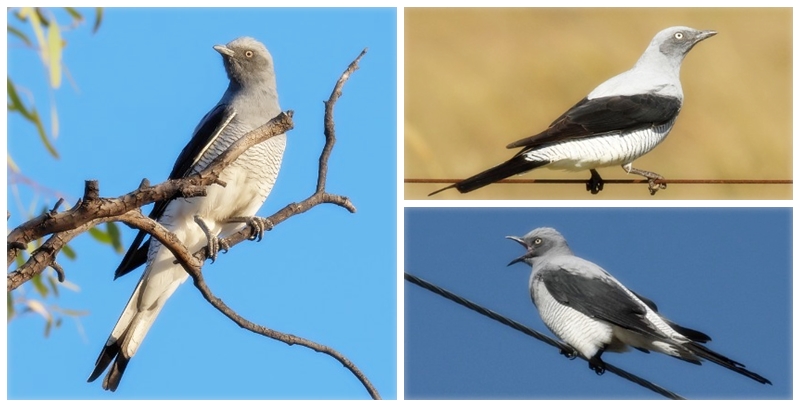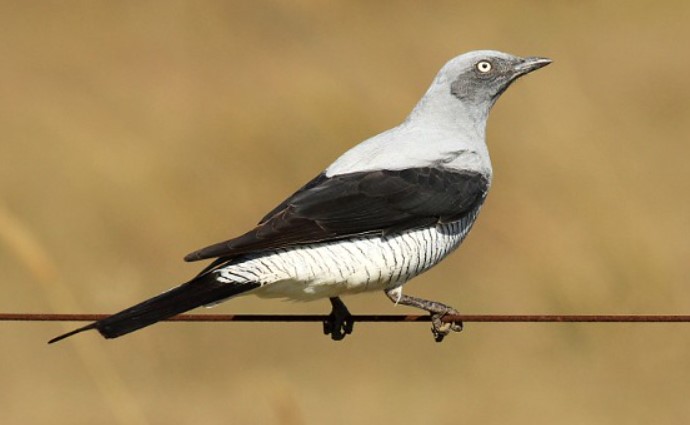Habitats: The Ground Cuckoo-shrike (Coracina maxima) is the only member of its family that walks and feeds on the ground. Due to its long legs, it is able to run well. Australian magpies and butcherbirds also display this reversal, with the ground-living magpies having contrasting white on their backs instead of their breasts. In drier parts of Australia, ground cuckoo shrikes live on plains with short grass and shrub steppes where there are scattered small trees for nesting and roosting.
Diet: It walks briskly, nodding backward and forward like a pigeon as it picks grasshoppers, beetles, and other insects from the ground among tussocks and shrubs. When it comes to capturing a flying insect, it has been known to leap into the air. The praying mantis feeds on adult and larval arthropods, including grasshoppers, locusts, ants, and spiders.

Behavior: There is perhaps some correlation between the bird’s ability to forage on the ground and the contrasting plumage patterns on their backs: startling white, barred rumps, light gray heads and backs, and black wings and tails. It is the opposite of the ventrally contrasting patterns that are found in other cuckoo shrikes, and it can be seen in birds that take off low to the ground and can be used as a signal to alert or keep in contact with others.
There, they have established themselves along the central coast of Queensland since 1950. They are nomadic and occasionally wander out to coastal regions. The Ground Cuckoo-shrike is also a communal bird. It is common for them to flock in small groups of three to seven, although sometimes they are found in only one or two. Family parties probably comprise mostly parents and young from previous years. During the day, they feed and roost together, sleeping in trees and resting on fence posts and bare branches.
Call: Cuckoo shrikes are carrying high, tinkling ti-yews, ti-yews carried by both sexes, typically at night in bright conditions. In addition, there are other notes that are almost metallic; one is similar to galink galink. Their tinkling contact notes are uttered continuously while they fly from point to point on somewhat down swept wings and flutter-and-glide. Upon landing, they flick one wing, then the other, into place in characteristic cuckoo-shrike fashion.
Identification: In terms of identification, both sexes are similar to adults. The crown, upper back, scapulars, and breast are light gray; the face is duskier. Breasts, belly, and rump are white, finely barred with black. The wings are black; the long, forked tail is black with a white tip. The eyes and bill of this bird are pale yellow, and its feet and bill are black. When mature, the back of the neck, the mantle, and the throat are faintly barred instead of being plain gray. A fine white edge surrounds the quills of the wings.

Nest & Breeds: Nesting and breeding occur between August and December, but in deserts anytime after good rains. Cobwebs, wool, feathers, and fine twigs make up the nest, which is well-bound in a shallow bowl with soft, relatively loose cobwebs. There is also a communal aspect to nesting. The nest is often shared by more than one female and other birds besides the parental pair contribute to its maintenance and feeding. Usually constructed into a horizontal fork of a shrubby tree such as mulga, she-oak, or pine, which can range in height from 3 to 23 meters.
Eggs & Incubation: There are usually two or three eggs laid by Ground Cuckoo-shrikes; the eggs are dull green or unmarked, but the brown markings are indistinct. Eggs measure about 34 x 24 mm and are oval-shaped, and tapered in shape. At least two clutches have been recorded in a nest; both occupants are responsible for incubation.
Distribution: All interior, except Gulfo/Carpentaria and central eastern Queensland, has Ground Cuckoo-shrike, which is found in savannas and shrub steppes. They are nomadic and widely dispersed in small numbers. The species inhabits mostly semi-arid regions of Australia’s east coast and inland of the Great Dividing Range.
Alternative Name: This cuckoo is also known as Ground Jay and Long-tailed Jay.
Size: The size of the Ground Cuckoo-shrike is about 330-360 mm in length, including a 200 mm tail.
Status: Ground cuckoo shrikes have a conservation status of least concern, despite their declining population.
Threats: The increase in woody vegetation density could pose a threat to the ground cuckoo-shrike. Ground cuckoo shrikes, which live in open woodland habitats, could be adversely affected by this. Most woodland bird species would benefit from this, but not the ground cuckoo-shrike.
Races: There are no races.
